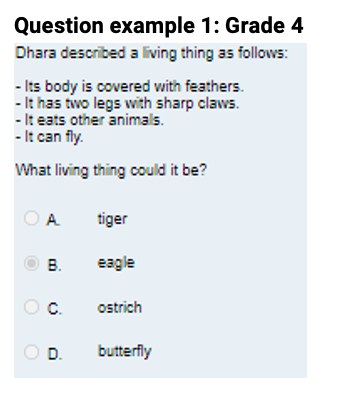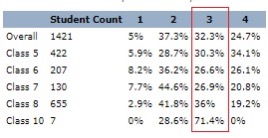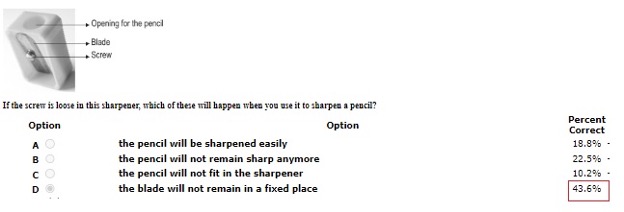- December 4, 2023
- by Educational Initiatives
- Blog
- 0 Comments
There is science all around us. Yet, understanding the whys and hows of various scientific processes (like why certain things sink while others float) is perhaps one of the most difficult tasks for a student to undertake (and therefore, for a teacher to facilitate!). Data (shared later in this discussion and as experienced by teachers) suggests that students often struggle to relate to abstract science concepts as most of this is not natural visible to them (eg: cells and their organelles, concepts of atoms and molecules, forces and energy) While the NEP 2020 talks of experiential learning and critical thinking as basis of pedagogy in preparatory and middle stages, the National Research Council’s (NRC) Framework (U.S.A.) describes a vision of what it means to be proficient in science. It drives on the importance of science learning being based on both knowledge and experience as evidence to support such knowledge. It presents three dimensions that will be combined to form each standard:
Dimension 1: Practices
The practices describe behaviours that scientists engage in as they investigate and build models and theories about the natural world. The NRC uses the term ‘practices’ instead of a term like “skills’” to emphasize that engaging in scientific investigation requires not only skill but also knowledge that is specific to each practice. Since the learning of scientific concepts depends a lot on building mental models based on experience and comprehension, developing skills that help to build correct models both mental and transforming them into working models, is important
Dimension 2: Cross- cutting Concepts
Cross-cutting concepts have applications across all domains of science. As such, they are a way of linking the different domains of science. They include Patterns, similarity, and diversity; Cause and effect; Scale, proportion and quantity; Systems and system models; Energy and matter; Structure and function; Stability and change. The Framework emphasizes that these concepts need to be made explicit for students because they provide an organizational schema for interrelating knowledge from various science fields into a coherent and scientifically-based view of the world. This may go a long way in helping students make sense of the world around them and connecting experiences to knowledge.
Dimension 3: Disciplinary Core Sciences
Disciplinary core ideas have the power to focus on grades 1–12 science curriculum, instruction and assessments on the most important aspects of science. To be considered core, the ideas should meet at least two of the following criteria and ideally all four:
- have broad importance across multiple sciences or engineering disciplines or be a key organizing concept of a single discipline;
- provide a key tool for understanding or investigating more complex ideas and solving problems;
- relate to the interests and life experiences of students or be connected to societal or personal concerns that require scientific or technological knowledge;
- be teachable and learnable over multiple grades at increasing levels of depth and sophistication.
NCERT in its Position Paper titled ‘National Focus Group on Teaching of Science’ speaks of three basic criteria to validate any science curriculum:
Cognitive validity requires that the content, process, language and pedagogical practices of the curriculum are age appropriate, and within the cognitive reach of the child.
Content validity requires that the curriculum must convey significant and scientifically correct content. Simplification of content, which is often necessary to adapt the curriculum to the cognitive level of the learner, must not be so trivialized as to convey something basically flawed and/or meaningless.
Process validity requires that the curriculum engage the learner in acquiring the methods and processes that lead to generation and validation of scientific knowledge, and nurture the natural curiosity and creativity of the child. Process validity is an important criterion since it helps in ‘learning to learn’ science.
While cognitive validity and content validity are usually checked in the process of creation of the curriculum, it is the transaction of the (often) abstract concepts that requires deeper thought. To make science learning comprehensible and engaging, the amalgamation of process skills into the lesson plan can be useful. Process skills can be identified as being reflective of the behaviour of scientists: the basis of being curious of the phenomena that govern the scientific world around us.
There are six process skills that are central to the learning of science and they bring the three dimensions mentioned earlier in this discussion, together. These skills help develop scientific literacy, understanding and temper by forming the basis of mental models, investigative behaviour and interconnecting observations.
- Observing: using the senses to gather information about an object, event or system around us.eg.: we observe and gather understanding about the phenomenon of night and day (even without being “taught” about it)
- Inferring: the ability to make an “educated guess” about a process or event. This depends on data or information that we have gathered, usually through previous experience. e.g. the moon can be seen because it is night or the its time to go to school as the sun is up.
- Measuring: can be done through both use of standard and non-standard measures/units. This becomes quite intuitive to children as they grow up being able to identify objects that are bigger or smaller than each other or actually measuring objects using meter scales etc.
- Communicating: Being able to describe events, processes, objects around us is a part of communicating what we observe. In the learning of science, communication is vital to be able to note and express observations and move up in the process of decision-making.
- Classifying: classification is important in bucketing similar events or objects and helps in minimizing cognitive load. When used in classroom instructional practice, it helps students to build connections between events and objects easily so that understanding is deeper and better retained.
- Predicting: hypothesizing and predicting outcomes is an important domain in science and the use of all the other process skills mentioned here can lead to critical thinking and therefore aid in logical predictions. We may think about prediction of the outcome of a phenomenon while conditions change or characteristics of the objects vary. e.g. prediction of changes in the global climate 20 years hence and how we may stop that or even adapt to the same.
While incorporation of process skills in classroom teaching helps in the development of scientific temper and critical thinking abilities, including question items that seek for such skills in assessments can also increase understanding of scientific concepts manifold. Let’s understand this better with the help of the following example.
While teaching a concept of soluble and insoluble substances ( and driving the concept of solubility), the faciliator can incorporate all the process skills consciously:
- have students observe whether sugar and chalk dust dissolve in water
- ask students to infer what is the difference in the type of material
- help students measure the quantity of each substance that behaves differently in different measures of water
- let students articulate such differences and communicate in their own words
- hence let students classify the substances as soluble and insoluble in water
- and finally lead students to predict the solubility of substances X, Y and Z in water
A lot of this is being done in classrooms, though not consciously. If they are consciously brought to science classrooms, it becomes habit-forming for students to look more critically at different phenomena. The dimension of cross-cutting concepts, leading to science being more relatable to students becomes an integrated part of science teaching-learning in this way.
Educational Initiatives (Ei) has been incorporating such aspects in its regular assessments over all these years. The data of student performance validates the impact that the logical flow of process skills can have on student understanding and how powerful a tool it is for helping teachers gauge student learning better.
Let us look at some such question examples from the Ei repository: (the examples may have overlaps across process skills, as is expected in any classification of cognitive domains)

The question tests the ability to connect to a description and identify the correct object. While this might not be a regular way of teaching grade 4 students, the use of such question items can help augment the process skill of observation in students in their early years.

“Fill in the blank” questions can most often tend to be direct recall questions, often directly pasted from the textbook.While observing that animals are competing with each other and preying on the same type of organism comes more naturally to students, this question requires the students to apply this observation and knowledge from content to be able to infer the nature of the population being spoken about.
Data available for students attempting this question suggests that connecting information given in a question stem to prior knowledge to draw an inference may be a concern across grades.

The ability to choose option 3 suggests the ability to infer that dependence on the same organism for food in the ecosystem will lead to competition.
Question example 3: Grade 10

In the above question, the students comprehend the information given in the question stem on the basis of fat providing heat to raise temperatures. It might have stemmed from the common belief that fatter individuals feel hotter than people with less fat. This basic misconception leads to 33% of students predicting incorrectly and choosing option A. The ability to make connections between basic knowledge ( mitochondria generate ATP and thus heat energy too) and the information given in the question will lead to correct inference and prediction. So, the entire route of process skills starting from the observation of differences in characteristics stated in the question stem to being able to classify and predict is vital to answering this question correctly.
Question example 4: Grade 3

Analysis of data for this question suggests that there is an inadequate application of practical knowledge in almost 57 percent of the student population attempting this. This affects the correctness of predicting the outcome of the situation presented in the question.
Incorporation of science process skills consciously into lesson plans for classroom instructional practices can help connect scientific knowledge to experiences. Classroom facilitators can include these logically in, both, the learning flow as well as assessment flows. Making logical connections can, in turn, lead to a better comprehension of science concepts through critical thinking.
References used :
https://narst.org/research-matters/science-process-skills
https://ncert.nic.in/pdf/focus-group/science.pdf
